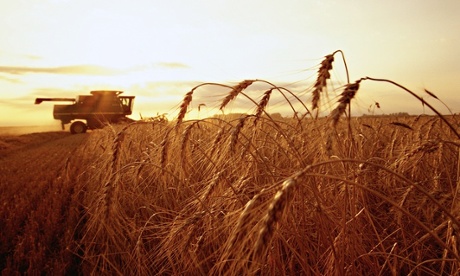Think about risk
You can put up to £20,000 in an investment Isa before 6 April and you won’t pay tax on the profits. Choosing a fund rather than individual stocks and shares means you can invest in dozens of companies and spread your risk, while targeting inflation-beating returns.
The stock market may be your only chance of keeping pace with the rising cost of living, if you can hold your nerve when markets face a bumpy ride. But as a general rule of thumb, the sooner you need your money, the less risk you should take, as you won’t have as much time to ride out the highs and lows of the market.
Laura Suter, the head of personal finance at AJ Bell, says: “Someone’s pension that they don’t plan to touch for 30 years will have different funds from an investment pot that’ll go towards a new car in five years’ time.”
There are plenty of ways to assess a fund’s risk. It may be gauged, for example, by how sharply its performance moves up and down, shown on a graph on the investment provider’s website.
If you’re happy taking a relatively high level of risk, you can choose a fund solely invested in shares. But if you want to reduce risk, a fund invested in a variety of assets, including corporate and government bonds and some cash, may be more suitable.
Do some research
Investment Isas are available from high street banks and investment providers, but with thousands of funds to choose from, knowing where to start can be daunting.
However, there are lots of experts who follow performance and their guidance can help you narrow down your choices.
You can find lists of expert fund picks on a variety of websites, alongside a variety of research tools if you want to dig any deeper into a particular fund. For example, check out Interactive Investor’s Super 60, Hargreaves Lansdown’s Wealth Shortlist, Fidelity’s Tom’s Picks and AJ Bell’s Favourite Funds. The funds highlighted on these sites often consistently outperform, and are generally considered a solid choice for any investor.
You can also check a fund’s rating on the Morningstar and Trustnet websites. For example, Morningstar awards ratings based on past performance, and analysts’ gold, silver, bronze, neutral or negative ratings that give an idea of how well they expect the fund to perform in future.
Find a one-stop-shop …
A multi-asset fund that holds companies from around the world is a good option if you want to keep things simple and just invest in one fund. “If you choose a broad global fund invested in lots of different countries and types of companies, it will be more diversified and so less likely to react extremely negatively to bad news or one market falling,” says Suter.
These are essentially a diversified investment portfolio within a single fund. Interactive Investor’s Quick-start funds include three of Vanguard’s LifeStrategy funds and BMO Sustainable funds, with options for cautious and more adventurous investors.
Emma Wall, head of investment analysis and research at Hargreaves Lansdown, says: “For one-stop-shop funds, we like … Troy Trojan which hold stocks, bonds, cash and gold, and Schroder Managed Balanced which alongside stocks and bonds also invests in property and alternatives.”
… or a mix
You may have a particular sector that you want to invest in, such as renewable energy providers or smaller companies, or you may want to invest in a fund focused in a specific region.
But remember that these types of funds are generally best as part of a portfolio, with other investments that aren’t focused on the same thing. “Investing all your cash into a UK smaller companies fund means that when the sector falls out of favour, you’re up against it, however talented the fund manager,” says Wall.
Many investors start with a multi-asset fund, or an index tracker that follows the performance of a particular market, such as the MSCI World, or FTSE 100, and add other funds to this over time.
You can find the objectives of a fund on its fund factsheet, available from investment websites, from Trustnet.com or from the company selling the fund. This will show the top 10 companies the fund invests in and enable you to gauge how it has performed.
Check charges
How much you pay for your fund can make a huge difference to your returns over time.
Trackers are the cheapest option because no one has to make a decision about the investments. As active funds come with a manager who chooses which shares to buy, with the aim of beating the market, they’re more expensive.
Average charges on active funds are about 0.75% a year (although they can be as high as 1.5%), but you can pay as a little as 0.1% for an index tracker.
Remember you’ll also pay a fee to the investment provider you buy the fund from, but how much you pay often depends on the range of investment choice. Vanguard is one of the cheapest, at just 0.15% a year, but offers limited choice. Fidelity usually charges 0.35% a year, and you can choose from a wide range of funds.
Don’t delay
If you’re lucky enough to have some cash to invest, make sure you do so before 6 April - if you don’t use your Isa allowance by the end of the tax year you lose it.
Myron Jobson, a senior personal finance analyst at Interactive Investor, says: “Your money will also be in the market longer if it’s put to work sooner, and while markets will have good years and bad, over the long term this increases your potential for profits.”
If you’re nervous of investing your Isa allowance in the market because this money will be tied up for some time, and the cost of living is rising, that’s not necessarily a reason to delay. You can start small by investing just £25 a month into your chosen fund. This way, you buy more shares when the stock market is performing badly, and fewer when their value rises, which can help to even out performance over time, too.
Should you choose to open an Isa and set up a regular payment like this, you will only be making a small contribution in this tax year. Future monthly payments into it will come out of the allowance for the tax year they are made in.
At any point in the tax year you can move money from a cash Isa into a stocks and shares version, or vice versa – as long as the new provider takes transfers.











